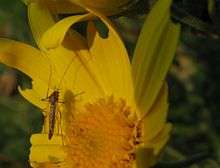Chironomidae
The Chironomidae (informally known as chironomids, nonbiting midges, or lake flies) comprise a family of nematoceran flies with a global distribution. They are closely related to the Ceratopogonidae, Simuliidae, and Thaumaleidae. Many species superficially resemble mosquitoes, but they lack the wing scales and elongated mouthparts of the Culicidae. An example of mosquito-resembling species is Tokunagayusurika akamusi.
| Chironomidae | |
|---|---|
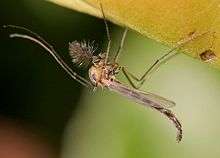 | |
| Male Chironomus plumosus | |
| Scientific classification | |
| Kingdom: | Animalia |
| Phylum: | Arthropoda |
| Class: | Insecta |
| Order: | Diptera |
| Suborder: | Nematocera |
| Infraorder: | Culicomorpha |
| Superfamily: | Chironomoidea |
| Family: | Chironomidae Erichson, 1841 |
| Subfamilies | |
|
See text | |
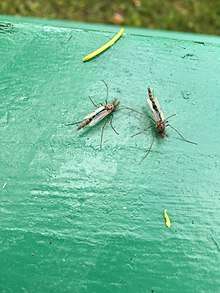
The name Chironomidae stems from the Ancient Greek word kheironómos, "a pantomimist".
Common names and biodiversity
This is a large taxon of insects; some estimates of the species numbers suggest well over 10 000 world-wide.[1] Males are easily recognized by their plumose antennae. Adults are known by a variety of vague and inconsistent common names, largely by confusion with other insects. For example, chironomids are known as "lake flies" in parts of Canada and Lake Winnebago, Wisconsin, but "bay flies" in the areas near the bay of Green Bay, Wisconsin. They are called "sand flies", "muckleheads",[2] "muffleheads",[3] "Canadian soldiers",[4] or "American soldiers"[5] in various regions of the Great Lakes area. They have been called "blind mosquitoes" or "chizzywinks" in Florida.[6] However, they are not mosquitoes of any sort, and the term "sandflies" generally refers to various species of biting flies unrelated to the Chironomidae.
The group includes the wingless Belgica antarctica, the largest terrestrial animal of Antarctica.[7][8]
The biodiversity of the Chironomidae often goes unnoticed because they are notoriously difficult to identify and ecologists usually record them by species groups. Each morphologically distinct group comprises a number of morphologically identical (sibling) species that can only be identified by rearing adult males or by cytogenetic analysis of the polytene chromosomes. Polytene chromosomes were originally observed in the larval salivary glands of Chironomus midges by Balbiani in 1881. They form through repeated rounds of DNA replication without cell division, resulting in characteristic light and dark banding patterns which can be used to identify inversions and deletions which allow species identification.
Behavior and description
Larval stages of the Chironomidae can be found in almost any aquatic or semiaquatic habitat, including treeholes, bromeliads, rotting vegetation, soil, and in sewage and artificial containers. They form an important fraction of the macro zoobenthos of most freshwater ecosystems. They are often associated with degraded or low-biodiversity ecosystems because some species have adapted to virtually anoxic conditions and are dominant in polluted waters. Larvae of some species are bright red in color due to a hemoglobin analog; these are often known as "bloodworms".[9] Their ability to capture oxygen is further increased by their making undulating movements.[10]
Many reference sources in the past century or so have repeated the assertion that the Chironomidae do not feed as adults, but an increasing body of evidence contradicts this view. Adults of many species do, in fact, feed. The natural foods reported include fresh fly droppings, nectar, pollen, honeydew, and various sugar-rich materials.[1]
The question whether feeding is of practical importance has by now been clearly settled for some Chironomus species, at least; specimens that had fed on sucrose flew far longer than starved specimens, and starved females longer than starved males, which suggested they had eclosed with larger reserves of energy than the males. Some authors suggest the females and males apply the resources obtained in feeding differently. Males expend the extra energy on flight, while females use their food resources to achieve longer lifespans. The respective strategies should be compatible with maximal probability of successful mating and reproduction in those species that do not mate immediately after eclosion, and in particular in species that have more than one egg mass maturing, the less developed masses being oviposited after a delay. Such variables also would be relevant to species that exploit wind for dispersal, laying eggs at intervals. Chironomids that feed on nectar or pollen may well be of importance as pollinators, but current evidence on such points is largely anecdotal. However, the content of protein and other nutrients in pollen, in comparison to nectar, might well contribute to the females' reproductive capacities.[1]
Adults can be pests when they emerge in large numbers. They may cause difficulty during driving if they collide with the windshield, creating an opaque coating which obscures the driver's vision.[11] They can damage paint, brick, and other surfaces with their droppings. When large numbers of adults die, they can build up into malodorous piles. They can provoke allergic reactions in sensitive individuals.[12]
Ecology
Larvae and pupae are important food items for fish, such as trout, banded killifish, and sticklebacks, and for many other aquatic organisms as well such as newts. Many aquatic insects, such as various predatory hemipterans in the families Nepidae, Notonectidae, and Corixidae eat Chironomidae in their aquatic phases. So do predatory water beetles in families such as the Dytiscidae and Hydrophilidae. The flying midges are eaten by fish and insectivorous birds, such as swallows and martins. They are also thought to be an especially important food source for tufted duck chicks during their first few days of life. They also are preyed on by bats and flying predatory insects, such as Odonata and dance flies.
The Chironomidae are important as indicator organisms, i.e., the presence, absence, or quantities of various species in a body of water can indicate whether pollutants are present. Also, their fossils are widely used by palaeolimnologists as indicators of past environmental changes, including past climatic variability.[13] Contemporary specimens are used by forensic entomologists as medico-legal markers for the postmortem interval assessment.[14]
A number of chironomid species inhabit marine habitats. Midges of the genus Clunio are found in the intertidal zone, where they have adjusted their entire life cycle to the rhythm of the tides. This made the species Clunio marinus an important model species for research in the field of chronobiology.[15]
Anhydrobiosis and stress resistance
Anhydrobiosis is the ability of an organism to survive in the dry state. Anhydrobiotic larvae of the African chironomid Polypedilum vanderplanki can withstand prolonged complete desiccation (reviewed by Cornette and Kikawada[16]). These larvae can also withstand other external stresses including ionizing radiation.[17] The effects of anhydrobiosis, gamma ray and heavy-ion irradiation on the nuclear DNA and gene expression of these larvae were studied by Gusev et al.[17] They found that larval DNA becomes severely fragmented both upon anhydrobiosis and irradiation, and that these breaks are later repaired during rehydration or upon recovery from irradiation. An analysis of gene expression and antioxidant activity suggested the importance of removal of reactive oxygen species as well as the removal of DNA damages by repair enzymes. Expression of genes encoding DNA repair enzymes increased upon entering anhydrobiosis or upon exposure to radiation, and these increases indicated that when DNA damages occurred, they were subsequently repaired. In particular, expression of the Rad51 gene was substantially up-regulated following irradiation and during rehydration.[17] The Rad51 protein plays a key role in homologous recombination, a process required for the accurate repair of DNA double-strand breaks.
Subfamilies and genera
The family is divided into 11 subfamilies: Aphroteniinae, Buchonomyiinae, Chilenomyinae, Chironominae, Diamesinae, Orthocladiinae, Podonominae, Prodiamesinae, Tanypodinae, Telmatogetoninae, and Usambaromyiinae.[18][19] Most species belong to Chironominae, Orthocladiinae, and Tanypodinae. Diamesinae, Podonominae, Prodiamesinae, and Telmatogetoninae are medium-sized subfamilies with tens to hundreds of species. The remaining four subfamilies have fewer than five species each.
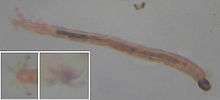
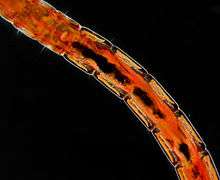
- Aagaardia Sæther, 2000
- Abiskomyia Edwards, 1937
- Ablabesmyia Johannsen, 1905
- Acalcarella
- Acamptocladius Brundin, 1956
- Acricotopus Kieffer, 1921
- Aedokritus
- Aenne
- Afrochlus
- Afrozavrelia Harrison, 2004[20]
- Allocladius
- Allometriocnemus
- Allotrissocladius
- Alotanypus Roback, 1971
- Amblycladius
- Amnihayesomyia
- Amphismittia
- Anaphrotenia
- Anatopynia Johannsen, 1905
- Ancylocladius
- Andamanus
- Antillocladius Sæther, 1981
- Anuncotendipes
- Apedilum Townes, 1945
- Aphrotenia
- Aphroteniella
- Apometriocnemus Sæther, 1984
- Apsectrotanypus Fittkau, 1962
- Archaeochlus
- Arctodiamesa Makarchenko, 1983[21]
- Arctopelopia Fittkau, 1962
- Arctosmittia
- Asachironomus
- Asclerina
- Asheum Sublette & Sublette, 1983
- Australopelopia
- Austrobrillia
- Austrochlus
- Austrocladius
- Axarus Roback 1980
- Baeoctenus
- Baeotendipes Kieffer, 1913
- Bavarismittia
- Beardius Reiss & Sublette, 1985
- Beckidia Sæther 1979
- Belgica
- Bernhardia
- Bethbilbeckia
- Biwatendipes
- Boreochlus Edwards, 1938
- Boreoheptagyia Brundin 1966
- Boreosmittia
- Botryocladius
- Brillia Kieffer, 1913
- Brundiniella
- Brunieria
- Bryophaenocladius Thienemann, 1934
- Buchonomyia Fittkau, 1955
- Caladomyia
- Camposimyia
- Camptocladius van der Wulp, 1874
- Cantopelopia
- Carbochironomus Reiss & Kirschbaum 1990
- Cardiocladius Kieffer, 1912
- Chaetocladius Kieffer, 1911
- Chasmatonotus
- Chernovskiia Sæther 1977
- Chilenomyia
- Chirocladius
- Chironomidae (genus)
- Chironominae
- Chironomini
- Chironomus Meigen, 1803
- Chrysopelopia
- Cladopelma Kieffer, 1921
- Cladotanytarsus Kieffer, 1921
- Clinotanypus Kieffer, 1913
- Clunio Haliday, 1855
- Coelopynia
- Coelotanypus
- Coffmania
- Collartomyia
- Colosmittia
- Compteromesa Sæther 1981
- Compterosmittia
- Conchapelopia Fittkau, 1957
- Conochironomus
- Constempellina Brundin, 1947
- Corynocera Zetterstedt, 1838
- Corynoneura Winnertz, 1846
- Corynoneurella Brundin, 1949
- Corytibacladius
- Cricotopus van der Wulp, 1874
- Cryptochironomus Kieffer, 1918
- Cryptotendipes Lenz, 1941
- Cyphomella Sæther 1977
- Dactylocladius
- Daitoyusurika
- Demeijerea Kruseman, 1933
- Demicryptochironomus Lenz, 1941
- Denopelopia
- Derotanypus
- Diamesa Meigen in Gistl, 1835
- Diamesinae
- Dicrotendipes Kieffer, 1913
- Diplocladius Kieffer, 1908
- Diplosmittia
- Djalmabatista Fittkau, 1968
- Doithrix
- Doloplastus
- Doncricotopus
- Dratnalia
- Echinocladius
- Edwardsidia
- Einfeldia Kieffer, 1924
- Endochironomus Kieffer, 1918
- Endotribelos
- Epoicocladius Sulc & ZavÍel, 1924
- Eretmoptera
- Eukiefferiella Thienemann, 1926
- Eurycnemus van der Wulp, 1874
- Euryhapsis Oliver, 1981
- Eusmittia
- Fissimentum
- Fittkauimyia
- Fleuria
- Freemaniella
- Friederia
- Georthocladius Strenzke, 1941
- Gillotia Kieffer, 1921
- Glushkovella
- Glyptotendipes Kieffer, 1913
- Goeldichironomus
- Graceus Goetghebuer, 1928
- Gravatamberus
- Gressittius
- Guassutanypus
- Guttipelopia Fittkau, 1962
- Gymnometriocnemus Goetghebeur, 1932
- Gynnidocladius
- Gynocladius Mendes, Sæther & Andrade-Morraye, 2005
- Hahayusurika
- Halirytus
- Halocladius Hirvenoja, 1973
- Hanochironomus
- Hanocladius
- Harnischia Kieffer, 1921
- Harrisius
- Harrisonina
- Hayesomyia Murray & Fittkau, 1985
- Heleniella Gouin, 1943
- Helopelopia Roback, 1971
- Henrardia
- Heptagyia
- Heterotanytarsus Spärck, 1923
- Heterotrissocladius Spärck, 1923
- Hevelius
- Himatendipes
- Hirosimayusurika
- Hudsonimyia Roback, 1979[22]
- Hydrobaenus
- Hydrosmittia
- Hyporhygma
- Ichthyocladius Fittkau, 1974
- Ikiprimus
- Ikisecundus
- Imparipecten
- Indoaxarus
- Indocladius
- Ionthosmittia
- Irisobrillia
- Kaluginia
- Kamelopelopia
- Kaniwhaniwhanus
- Kiefferophyes
- Kiefferulus Goetghebuer, 1922
- Knepperia
- Kloosia Kruseman 1933
- Krenopelopia Fittkau, 1962
- Krenopsectra
- Krenosmittia Thienemann & Krüger, 1939
- Kribiobius
- Kribiocosmus
- Kribiodosis
- Kribiopelma
- Kribiothauma
- Kribioxenus
- Kurobebrillia
- Kuschelius
- Labrundinia Fittkau, 1962
- Lappodiamesa Serra-Tosio, 1968
- Lappokiefferiella
- Lapposmittia
- Larsia Fittkau, 1962
- Lasiodiamesa Kieffer, 1924
- Laurotanypus
- Lauterborniella Thienemann & Bause, 1913
- Lepidopelopia
- Lepidopodus
- Lerheimia
- Limaya
- Limnophyes Eaton, 1875
- Lindebergia
- Linevitshia
- Lipiniella Shilova 1961
- Lipurometriocnemus
- Lithotanytarsus
- Litocladius Andersen, Mendes & Sæther 2004
- Ljungneria
- Lobodiamesa
- Lobomyia
- Lobosmittia
- Lopescladius
- Lunditendipes
- Lyrocladius Mendes & Andersen, 2008
- Macropelopia Thienemann, 1916
- Macropelopini
- Manoa
- Maoridiamesa
- Mapucheptagyia
- Maryella
- Mecaorus
- Megacentron
- Mesocricotopus
- Mesosmittia Brundin, 1956
- Metriocnemus van der Wulp, 1874
- Microchironomus Kieffer, 1918
- Micropsectra Kieffer, 1909
- Microtendipes Kieffer, 1915
- Microzetia
- Molleriella
- Mongolchironomus
- Mongolcladius
- Mongolyusurika
- Monodiamesa Kieffer, 1922
- Monopelopia Fittkau, 1962
- Murraycladius
- Nakataia
- Nandeca
- Nanocladius Kieffer, 1913
- Naonella
- Nasuticladius
- Natarsia Fittkau, 1962
- Neelamia
- Neobrillia
- Neopodonomus
- Neostempellina
- Neozavrelia Goetghebuer, 1941
- Nesiocladius
- Nilodorum
- Nilodosis
- Nilotanypus Kieffer, 1923
- Nilothauma Kieffer, 1921
- Nimbocera
- Notocladius
- Odontomesa Pagast, 1947
- Okayamayusurika
- Okinawayusurika
- Olecryptotendipes Zorina, 2007[23]
- Oleia
- Oliveridia Sæther, 1980
- Omisus Townes, 1945
- Onconeura
- Ophryophorus
- Oreadomyia
- Orthocladiinae
- Orthocladius van der Wulp, 1874
- Oryctochlus
- Oukuriella
- Pagastia Oliver, 1959
- Pagastiella Brundin, 1949
- Paraboreochlus Thienemann, 1939
- Parachaetocladius
- Parachironomus Lenz, 1921
- Paracladius Hirvenoja, 1973
- Paracladopelma Harnisch, 1923
- Paracricotopus Thienemann & Harnisch, 1932
- Parakiefferiella Thienemann, 1936
- Paralauterborniella Lenz, 1941
- Paralimnophyes Brundin, 1956
- Paramerina Fittkau, 1962
- Parametriocnemus Goetghebuer, 1932
- Pamirocesa
- Paraborniella
- Parachironominae
- Paradoxocladius
- Paraheptagyia
- Paranilothauma
- Parapentaneura
- Paraphaenocladius Thienemann, 1924
- Paraphrotenia
- Parapsectra Reiss, 1969
- Parapsectrocladius
- Parasmittia
- Paratanytarsus Thienemann & Bause, 1913
- Paratendipes Kieffer, 1911
- Paratrichocladius Thienemann, 1942
- Paratrissocladius ZavÍel, 1937
- Parochlus Enderlein, 1912
- Parorthocladius Thienemann, 1935
- Parvitergum
- Paucispinigera
- Pelomus
- Pentaneura
- Pentaneurella
- Pentaneurini
- Pentapedilum
- Petalocladius
- Phaenopsectra Kieffer, 1921
- Physoneura
- Pirara
- Platysmittia Sæther, 1982
- Plhudsonia
- Podochlus
- Podonomopsis
- Podonomus
- Polypedilum Kieffer, 1912
- Pontomyia
- Potthastia Kieffer, 1922
- Prochironomus
- Procladiini
- Procladius Skuse, 1889
- Prodiamesa Kieffer, 1906
- Propsilocerus
- Prosmittia
- Protanypus Kieffer, 1906
- Psectrocladius Kieffer, 1906
- Psectrotanypus Kieffer, 1909
- Pseudobrillia
- Pseudochironomus Malloch, 1915
- Pseudodiamesa Goetghebuer, 1939
- Pseudohydrobaenus
- Pseudokiefferiella Zavrel, 1941
- Pseudorthocladius Goetghebuer, 1932
- Pseudosmittia Goetghebuer, 1932
- Psilochironomus
- Psilometriocnemus Sæther, 1969
- Pterosis
- Qiniella
- Reissmesa
- Rheochlus
- Rheocricotopus Brundin, 1956
- Rheomus
- Rheomyia
- Rheopelopia Fittkau, 1962
- Rheosmittia Brundin, 1956
- Rheotanytarsus Thienemann & Bause, 1913
- Rhinocladius
- Riethia
- Robackia Sæther, 1977
- Saetheria Jackson, 1977
- Saetheriella Halvorsen, 1982[24]
- Saetherocladius
- Saetherocryptus
- Saetheromyia
- Saetherops
- Sasayusurika
- Schineriella Murray & Fittkau, 1988
- Semiocladius
- Setukoyusurika
- Seppia
- Sergentia Kieffer, 1922
- Shangomyia
- Shilovia
- Skusella
- Skutzia
- Smittia Holmgren, 1869
- Stackelbergina
- Stelechomyia
- Stempellina Thienemann & Bause, 1913
- Stempellinella Brundin, 1947
- Stenochironomus Kieffer, 1919
- Stictochironomus Kieffer, 1919
- Stictocladius
- Stictotendipes
- Stilocladius Rossaro, 1979
- Sublettea
- Sublettiella
- Sumatendipes
- Symbiocladius Kieffer, 1925
- Sympotthastia Pagast, 1947
- Syndiamesa Kieffer, 1918
- Synendotendipes Grodhaus, 1987
- Synorthocladius Thienemann, 1935
- Tanypodinae
- Tanypus Meigen, 1803
- Tanytarsini
- Tanytarsus van der Wulp, 1874
- Tavastia
- Telmatogeton Schiner, 1866
- Telmatopelopia Fittkau, 1962
- Telopelopia
- Tempisquitoneura
- Tethymyia
- Thalassomya Schiner, 1856
- Thalassosmittia Strenzke & Remmert, 1957
- Thienemannia Kieffer, 1909
- Thienemanniella Kieffer, 1911
- Thienemannimyia Fittkau, 1957
- Thienemanniola
- Tobachironomus
- Tokunagaia Sæther, 1973
- Tokunagayusurika
- Tokyobrillia
- Tosayusurika
- Townsia
- Toyamayusurika
- Tribelos Townes, 1945
- Trichochilus
- Trichosmittia
- Trichotanypus Kieffer, 1906
- Trissocladius Kieffer, 1908
- Trissopelopia Kieffer, 1923
- Trondia
- Tsudayusurika
- Tusimayusurika
- Tvetenia Kieffer, 1922
- Unniella Sæther, 1982
- Usambaromyia Andersen & Sæther, 1994[25]
- Virgatanytarsus Pinder, 1982
- Vivacricotopus
- Wirthiella
- Xenochironomus Kieffer, 1921
- Xenopelopia Fittkau, 1962
- Xestochironomus
- Xestotendipes
- Xiaomyia
- Xylotopus
- Yaeprimus
- Yaequartus
- Yaequintus
- Yaesecundus
- Yaetanytarsus
- Yaetertius
- Yama
- Zalutschia Lipina, 1939
- Zavrelia Kieffer, 1913
- Zavreliella Kieffer, 1920
- Zavrelimyia Fittkau, 1962
- Zelandochlus
- Zhouomyia
- Zuluchironomus
C. Annularius
Chironomus annularius (commonly known as bayflies or muffleheads) is a species of non-biting midge in the family Chironomidae. It is usually found in regions with bodies of fresh water but can be found in almost every environment. It tends to form "hotspots" around specific areas. The species is distinguished by the size of its chromosomes and the lack of a proboscis.
References
- Armitage, P. D.; Cranston, P. S.; Pinder, L. C. V. (1995). The Chironomidae: biology and ecology of non-biting midges. London: Chapman & Hall. ISBN 978-0-412-45260-4.
- "Muckleheads" from Andre's Weather World (Andre Bernier, staff at WJW-TV), June 2, 2007.
- "You don't love muffleheads, but Lake Erie does", Sandusky Register, May 24, 2010.
- Galbincea, Barb, "Canadian Soldiers Invade Rocky River", The Plain Dealer, Cleveland.com, June 18, 2014, accessed June 3, 2015.
- "Call Them Mayflies, Not June Bugs, Biologist Says: University of Windsor Professor Dispels Mayfly Myths", CBC News, CBC.ca, May 29, 2012, accessed June 3, 2015.
- Chizzywinks are Blind Mosquitos by Dan Culbert of the University of Florida, August 17, 2005
- Usher, Michael B.; Edwards, Marion (1984). "A dipteran from south of the Antarctic Circle: Belgica antarctica (Chironomidae) with a description of its larva". Biological Journal of the Linnean Society. 23 (1): 19–31. doi:10.1111/j.1095-8312.1984.tb00803.x.
- Luke Sandro & Juanita Constible. "Antarctic Bestiary — Terrestrial Animals". Laboratory for Ecophysiological Cryobiology, Miami University. Archived from the original on 23 December 2008. Retrieved December 9, 2008.
- W.P. Coffman and L.C. Ferrington Jr. 1996. Chironomidae. pp. 635-754. In: R.W. Merritt and K.W. Cummins, eds. An Introduction to the Aquatic Insects of North America. Kendall/Hunt Publishing Company.
- Int Panis, L; Goddeeris, B.; Verheyen, R (1996). "On the relationship between vertical microdistribution and adaptations to oxygen stress in littoral Chironomidae (Diptera)". Hydrobiologia. 318 (1–3): 61–67. doi:10.1007/BF00014132.
- McConnaughey, Janet (June 19, 2019). "The Swarm: Billions of skeeter lookalikes plague New Orleans". Associated Press. Retrieved September 5, 2019.
- A. Ali. 1991. Perspectives on management of pestiferous Chironomidae (Diptera), an emerging global problem. Journal of the American Mosquito Control Association 7: 260-281.
- Walker, I. R. 2001. Midges: Chironomidae and related Diptera. pp. 43-66, In: J. P. Smol, H. J. B. Birks, and W. M. Last (eds). Tracking Environmental Change Using Lake Sediments. Volume 4. Zoological Indicators. Kluwer Academic Publishers, Dordrecht.
- González Medina A, Soriano Hernando Ó, Jiménez Ríos G (2015). "The Use of the Developmental Rate of the Aquatic Midge Chironomus riparius (Diptera, Chironomidae) in the Assessment of the Postsubmersion Interval". J. Forensic Sci. 60 (3): 822–826. doi:10.1111/1556-4029.12707. hdl:10261/123473. PMID 25613586.
- Kaiser, Tobias S.; Poehn, Birgit; Szkiba, David; Preussner, Marco; Sedlazeck, Fritz J.; Zrim, Alexander; Neumann, Tobias; Nguyen, Lam-Tung; Betancourt, Andrea J. (2016). "The genomic basis of circadian and circalunar timing adaptations in a midge". Nature. 540 (7631): 69–73. doi:10.1038/nature20151. PMC 5133387. PMID 27871090.
- Cornette R, Kikawada T (June 2011). "The induction of anhydrobiosis in the sleeping chironomid: current status of our knowledge". IUBMB Life. 63 (6): 419–29. doi:10.1002/iub.463. PMID 21547992.
- Gusev O, Nakahara Y, Vanyagina V, Malutina L, Cornette R, Sakashita T, Hamada N, Kikawada T, Kobayashi Y, Okuda T (2010). "Anhydrobiosis-associated nuclear DNA damage and repair in the sleeping chironomid: linkage with radioresistance". PLoS ONE. 5 (11): e14008. doi:10.1371/journal.pone.0014008. PMC 2982815. PMID 21103355.
- J.H. Epler. 2001. Identification manual for the larval Chironomidae (Diptera) of North and South Carolina Archived 2005-12-14 at the Wayback Machine. North Carolina Department of Environment and Natural Resources.
- Armitage, P., Cranston, P.S., and Pinder, L.C.V. (eds.) (1994) The Chironomidae: Biology and Ecology of Non-biting Midges. Chapman and Hall, London, 572 pp.
- Ekrem, Torbjørn. "Systematics and biogeography of Zavrelia, Afrozavrelia and Stempellinella (Diptera: Chironomidae)". Archived from the original on 2009-03-18. Retrieved 2009-04-30.
- Makarchenko, Eugenyi A. (2005). "A new species of Arctodiamesa Makarchenko (Diptera: Chironomidae: Diamesinae) from the Russian Far East, with a key to known species of the genus" (PDF). Zootaxa. 1084: 59–64. doi:10.11646/zootaxa.1084.1.5. Retrieved 2009-04-03.
- Caldwell, Broughton A.; Soponis, Annelle R. (1982). "Hudsonimyia Parrishi, a New Species of Tanypodinae (Diptera: Chironomidae) from Georgia" (PDF). The Florida Entomologist. 65 (4): 506–513. doi:10.2307/3494686. ISSN 0015-4040. JSTOR 3494686. Retrieved 2009-04-20.
- Zorina, Oksana V. (2007). "Olecryptotendipes, a new genus in the Harnischia complex (Diptera: Chironomidae) from the Russian Far East" (PDF). In Andersen, T. (ed.). Contributions to the Systematics and Ecology of Aquatic Diptera—A Tribute to Ole A. Sæther. The Caddis Press. pp. 347–351.
- Halvorsen, Godtfred A. (1982). "Saetheriella amplicristata gen. n., sp. n., a new Orthocladiinae (Diptera: Chironomidae) from Tennessee". Aquatic Insects. 4 (3): 131–136. doi:10.1080/01650428209361098. ISSN 1744-4152.
- Andersen, Trond; Sæther, Ole A. (January 1994). "Usambaromyia nigrala gen. n., sp. n., and Usambaromyiinae, a new subfamily among the Chironomidae (Diptera)". Aquatic Insects. 16 (1): 21–29. doi:10.1080/01650429409361531. ISSN 1744-4152.
External links
| Wikispecies has information related to Chironomidae |
| Wikimedia Commons has media related to Chironomidae. |
- The Chironomid Home Page
- Chironomidae and Water Beetles of Florida
- Chironomidae Research Group, University of Minnesota
- Family Chironomidae at Soil and Water Conservation Society of Metro Halifax
- Checklist of UK Recorded Chironomidae
- Chironomidae at Nomina Insecta Nearctica
- Chironomid Palaeoecology @ UBC Okanagan
- Chironomidae at Australian Faunal Directory
- "Hydrilla tip mining midge". Featured Creatures. University of Florida Institute of Food and Agricultural Sciences.
- Diptera.info Images
